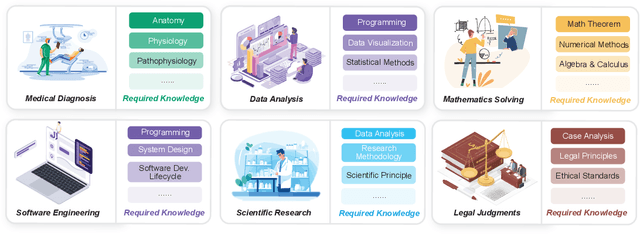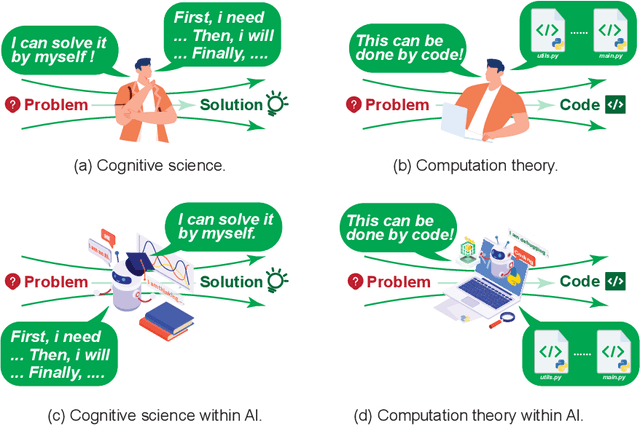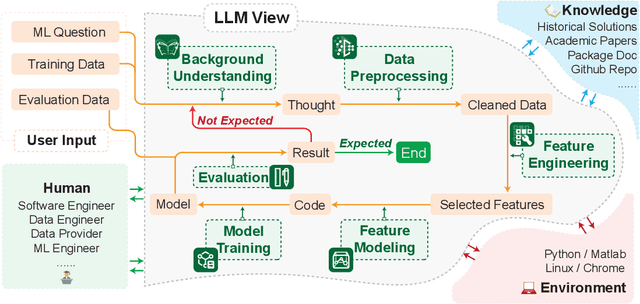Lun Du
EvolProver: Advancing Automated Theorem Proving by Evolving Formalized Problems via Symmetry and Difficulty
Oct 01, 2025Abstract:Large Language Models (LLMs) for formal theorem proving have shown significant promise, yet they often lack generalizability and are fragile to even minor transformations of problem statements. To address this limitation, we introduce a novel data augmentation pipeline designed to enhance model robustness from two perspectives: symmetry and difficulty. From the symmetry perspective, we propose two complementary methods: EvolAST, an Abstract Syntax Tree (AST) based approach that targets syntactic symmetry to generate semantically equivalent problem variants, and EvolDomain, which leverages LLMs to address semantic symmetry by translating theorems across mathematical domains. From the difficulty perspective, we propose EvolDifficulty, which uses carefully designed evolutionary instructions to guide LLMs in generating new theorems with a wider range of difficulty. We then use the evolved data to train EvolProver, a 7B-parameter non-reasoning theorem prover. EvolProver establishes a new state-of-the-art (SOTA) on FormalMATH-Lite with a 53.8% pass@32 rate, surpassing all models of comparable size, including reasoning-based models. It also sets new SOTA records for non-reasoning models on MiniF2F-Test (69.8% pass@32), Ineq-Comp-Seed (52.2% pass@32), and Ineq-Comp-Transformed (34.0% pass@32). Ablation studies further confirm our data augmentation pipeline's effectiveness across multiple benchmarks.
Automated Formalization via Conceptual Retrieval-Augmented LLMs
Aug 09, 2025



Abstract:Interactive theorem provers (ITPs) require manual formalization, which is labor-intensive and demands expert knowledge. While automated formalization offers a potential solution, it faces two major challenges: model hallucination (e.g., undefined predicates, symbol misuse, and version incompatibility) and the semantic gap caused by ambiguous or missing premises in natural language descriptions. To address these issues, we propose CRAMF, a Concept-driven Retrieval-Augmented Mathematical Formalization framework. CRAMF enhances LLM-based autoformalization by retrieving formal definitions of core mathematical concepts, providing contextual grounding during code generation. However, applying retrieval-augmented generation (RAG) in this setting is non-trivial due to the lack of structured knowledge bases, the polymorphic nature of mathematical concepts, and the high precision required in formal retrieval. We introduce a framework for automatically constructing a concept-definition knowledge base from Mathlib4, the standard mathematical library for the Lean 4 theorem prover, indexing over 26,000 formal definitions and 1,000+ core mathematical concepts. To address conceptual polymorphism, we propose contextual query augmentation with domain- and application-level signals. In addition, we design a dual-channel hybrid retrieval strategy with reranking to ensure accurate and relevant definition retrieval. Experiments on miniF2F, ProofNet, and our newly proposed AdvancedMath benchmark show that CRAMF can be seamlessly integrated into LLM-based autoformalizers, yielding consistent improvements in translation accuracy, achieving up to 62.1% and an average of 29.9% relative improvement.
Why Do Open-Source LLMs Struggle with Data Analysis? A Systematic Empirical Study
Jun 24, 2025Abstract:Large Language Models (LLMs) hold promise in automating data analysis tasks, yet open-source models face significant limitations in these kinds of reasoning-intensive scenarios. In this work, we investigate strategies to enhance the data analysis capabilities of open-source LLMs. By curating a seed dataset of diverse, realistic scenarios, we evaluate models across three dimensions: data understanding, code generation, and strategic planning. Our analysis reveals three key findings: (1) Strategic planning quality serves as the primary determinant of model performance; (2) Interaction design and task complexity significantly influence reasoning capabilities; (3) Data quality demonstrates a greater impact than diversity in achieving optimal performance. We leverage these insights to develop a data synthesis methodology, demonstrating significant improvements in open-source LLMs' analytical reasoning capabilities.
Right Is Not Enough: The Pitfalls of Outcome Supervision in Training LLMs for Math Reasoning
Jun 07, 2025Abstract:Outcome-rewarded Large Language Models (LLMs) have demonstrated remarkable success in mathematical problem-solving. However, this success often masks a critical issue: models frequently achieve correct answers through fundamentally unsound reasoning processes, a phenomenon indicative of reward hacking. We introduce MathOlympiadEval, a new dataset with fine-grained annotations, which reveals a significant gap between LLMs' answer correctness and their low process correctness. Existing automated methods like LLM-as-a-judge struggle to reliably detect these reasoning flaws. To address this, we propose ParaStepVerifier, a novel methodology for meticulous, step-by-step verification of mathematical solutions. ParaStepVerifier identifies incorrect reasoning steps. Empirical results demonstrate that ParaStepVerifier substantially improves the accuracy of identifying flawed solutions compared to baselines, especially for complex, multi-step problems. This offers a more robust path towards evaluating and training LLMs with genuine mathematical reasoning.
Autoformalization in the Era of Large Language Models: A Survey
May 29, 2025Abstract:Autoformalization, the process of transforming informal mathematical propositions into verifiable formal representations, is a foundational task in automated theorem proving, offering a new perspective on the use of mathematics in both theoretical and applied domains. Driven by the rapid progress in artificial intelligence, particularly large language models (LLMs), this field has witnessed substantial growth, bringing both new opportunities and unique challenges. In this survey, we provide a comprehensive overview of recent advances in autoformalization from both mathematical and LLM-centric perspectives. We examine how autoformalization is applied across various mathematical domains and levels of difficulty, and analyze the end-to-end workflow from data preprocessing to model design and evaluation. We further explore the emerging role of autoformalization in enhancing the verifiability of LLM-generated outputs, highlighting its potential to improve both the trustworthiness and reasoning capabilities of LLMs. Finally, we summarize key open-source models and datasets supporting current research, and discuss open challenges and promising future directions for the field.
Knowledge Augmented Complex Problem Solving with Large Language Models: A Survey
May 06, 2025



Abstract:Problem-solving has been a fundamental driver of human progress in numerous domains. With advancements in artificial intelligence, Large Language Models (LLMs) have emerged as powerful tools capable of tackling complex problems across diverse domains. Unlike traditional computational systems, LLMs combine raw computational power with an approximation of human reasoning, allowing them to generate solutions, make inferences, and even leverage external computational tools. However, applying LLMs to real-world problem-solving presents significant challenges, including multi-step reasoning, domain knowledge integration, and result verification. This survey explores the capabilities and limitations of LLMs in complex problem-solving, examining techniques including Chain-of-Thought (CoT) reasoning, knowledge augmentation, and various LLM-based and tool-based verification techniques. Additionally, we highlight domain-specific challenges in various domains, such as software engineering, mathematical reasoning and proving, data analysis and modeling, and scientific research. The paper further discusses the fundamental limitations of the current LLM solutions and the future directions of LLM-based complex problems solving from the perspective of multi-step reasoning, domain knowledge integration and result verification.
LightThinker: Thinking Step-by-Step Compression
Feb 21, 2025Abstract:Large language models (LLMs) have shown remarkable performance in complex reasoning tasks, but their efficiency is hindered by the substantial memory and computational costs associated with generating lengthy tokens. In this paper, we propose LightThinker, a novel method that enables LLMs to dynamically compress intermediate thoughts during reasoning. Inspired by human cognitive processes, LightThinker compresses verbose thought steps into compact representations and discards the original reasoning chains, thereby significantly reducing the number of tokens stored in the context window. This is achieved by training the model on when and how to perform compression through data construction, mapping hidden states to condensed gist tokens, and creating specialized attention masks. Additionally, we introduce the Dependency (Dep) metric to quantify the degree of compression by measuring the reliance on historical tokens during generation. Extensive experiments on four datasets and two models show that LightThinker reduces peak memory usage and inference time, while maintaining competitive accuracy. Our work provides a new direction for improving the efficiency of LLMs in complex reasoning tasks without sacrificing performance. Code will be released at https://github.com/zjunlp/LightThinker.
Extract Information from Hybrid Long Documents Leveraging LLMs: A Framework and Dataset
Dec 28, 2024



Abstract:Large Language Models (LLMs) demonstrate exceptional performance in textual understanding and tabular reasoning tasks. However, their ability to comprehend and analyze hybrid text, containing textual and tabular data, remains unexplored. The hybrid text often appears in the form of hybrid long documents (HLDs), which far exceed the token limit of LLMs. Consequently, we apply an Automated Information Extraction framework (AIE) to enable LLMs to process the HLDs and carry out experiments to analyse four important aspects of information extraction from HLDs. Given the findings: 1) The effective way to select and summarize the useful part of a HLD. 2) An easy table serialization way is enough for LLMs to understand tables. 3) The naive AIE has adaptability in many complex scenarios. 4) The useful prompt engineering to enhance LLMs on HLDs. To address the issue of dataset scarcity in HLDs and support future work, we also propose the Financial Reports Numerical Extraction (FINE) dataset. The dataset and code are publicly available in the attachments.
Guiding Large Language Models with Divide-and-Conquer Program for Discerning Problem Solving
Feb 08, 2024



Abstract:Foundation models, such as Large language Models (LLMs), have attracted significant amount of interest due to their large number of applications. Existing works show that appropriate prompt design, such as Chain-of-Thoughts, can unlock LLM's powerful capacity in diverse areas. However, when handling tasks involving repetitive sub-tasks and/or deceptive contents, such as arithmetic calculation and article-level fake news detection, existing prompting strategies either suffers from insufficient expressive power or intermediate errors triggered by hallucination. To make LLM more discerning to such intermediate errors, we propose to guide LLM with a Divide-and-Conquer program that simultaneously ensures superior expressive power and disentangles task decomposition, sub-task resolution, and resolution assembly process. Theoretic analysis reveals that our strategy can guide LLM to extend the expressive power of fixed-depth Transformer. Experiments indicate that our proposed method can achieve better performance than typical prompting strategies in tasks bothered by intermediate errors and deceptive contents, such as large integer multiplication, hallucination detection and misinformation detection.
TAROT: A Hierarchical Framework with Multitask Co-Pretraining on Semi-Structured Data towards Effective Person-Job Fit
Jan 17, 2024Abstract:Person-job fit is an essential part of online recruitment platforms in serving various downstream applications like Job Search and Candidate Recommendation. Recently, pretrained large language models have further enhanced the effectiveness by leveraging richer textual information in user profiles and job descriptions apart from user behavior features and job metadata. However, the general domain-oriented design struggles to capture the unique structural information within user profiles and job descriptions, leading to a loss of latent semantic correlations. We propose TAROT, a hierarchical multitask co-pretraining framework, to better utilize structural and semantic information for informative text embeddings. TAROT targets semi-structured text in profiles and jobs, and it is co-pretained with multi-grained pretraining tasks to constrain the acquired semantic information at each level. Experiments on a real-world LinkedIn dataset show significant performance improvements, proving its effectiveness in person-job fit tasks.
 Add to Chrome
Add to Chrome Add to Firefox
Add to Firefox Add to Edge
Add to Edge